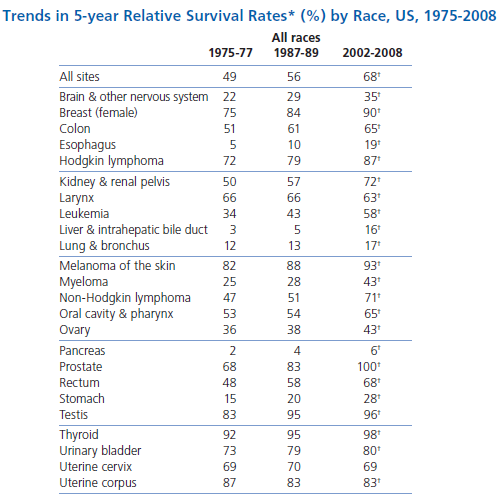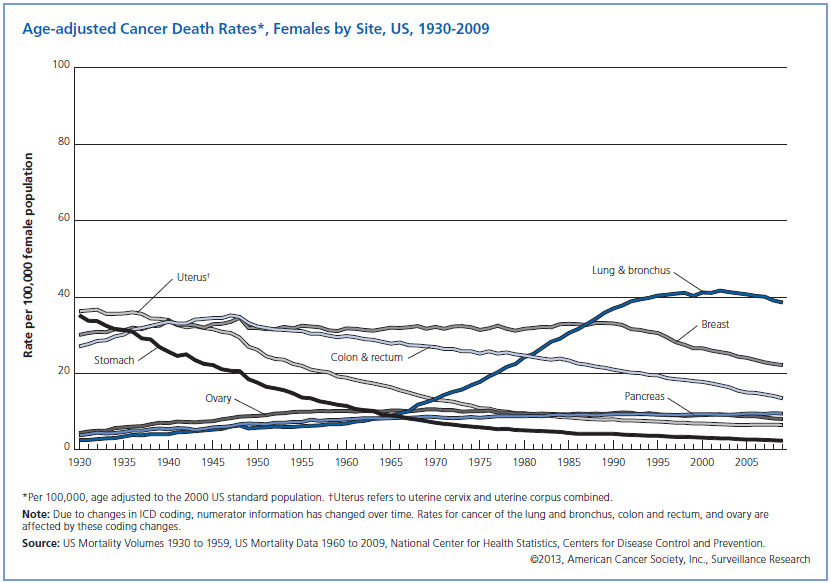The American Cancer Society just published their 2013 Facts and Figures report. It's kind of interesting to look at the time dependence of the rates. First for men:
Since 1990, the rate of lung (mostly smoking induced) cancer has been falling, presumably due to the government's concerted effort to force people to stop---absent any other compelling reason that we should believe rates would be falling so fast, this is reasonable and not surprising.
It's notable that, due to H. Pylori being wiped out by antibiotics, rates for stomach cancer have steadily fallen from 45/100,000 to only about 5/100,000, a factor of 9 decrease since 1930. For most intents and purposes, that cancer has been "cured", although its decline is due to prevention rather than actual curing once a patient has it.
Prostate cancer is the largest non-lung cancer. Oddly, "for reasons that remain unclear, incidence rates are 70% higher in African Americans than in whites", the report states. The two possibilities are difference in lifestyle or differences in genetics, but determining which is contributing is so far elusive. The death rate among African Americans to prostate cancer is double that of whites; presumably the balance is due to poverty and lack of good medical care. Deaths due to prostate cancer are falling for America overall. However, incidence rates for prostate cancer are also falling, at a rate of about 2% per year between 2005 and 2009.
For Women:
The vertical scale on these two charts is the same, and while all these curves are significantly smaller than that of men, it should not be construed that women die less often from cancer. In fact, the rate of death for women from all cancers is only about 10% smaller than men. The death from lady-parts cancers (breast and genitals) is about 68,000 per year, whereas men die of man-parts only about 31,000 cases per year, which explains this apparent discrepancy. Dispensing with gender-exclusive body parts, women have lower deaths of cancer of almost every part of the body.
| Male | Female | |
| Oral | 5500 | 2390 |
| Digestive | 82700 | 61870 |
| Respiratory | 90600 | 73290 |
| Bones | 810 | 630 |
| Soft tissue | 2500 | 1890 |
| Skin | 8560 | 4090 |
| Breast | 410 | 39620 |
| Genitals | 30400 | 28080 |
| Urinary | 20120 | 9670 |
| Eye | 120 | 200 |
| Lymphoma | 11250 | 8950 |
| Myeloma | 6070 | 4640 |
| Leukemia | 13660 | 10060 |
| Other | 25020 | 20400 |
| Total | 306920 | 273420 |
Survival rates (5 years past diagnosis) are highly dependent on body part. 90% of women will live 5 years beyond their diagnosis of breast cancer, and nearly 100% of men past their prostate cancer diagnosis. On the other hand, pancreatic cancer survival is a mere 6%, with liver and lung about 16-17%.

Medical science has made little progress in pancreatic cancers, but has nearly cured prostate and breast cancer since the 1970s. Significant improvement in leukemia, lymphoma, and testicular cancers has also been seen. For most categories, however, the decrease in deaths has been due not to treatment, but rather to prevention.







